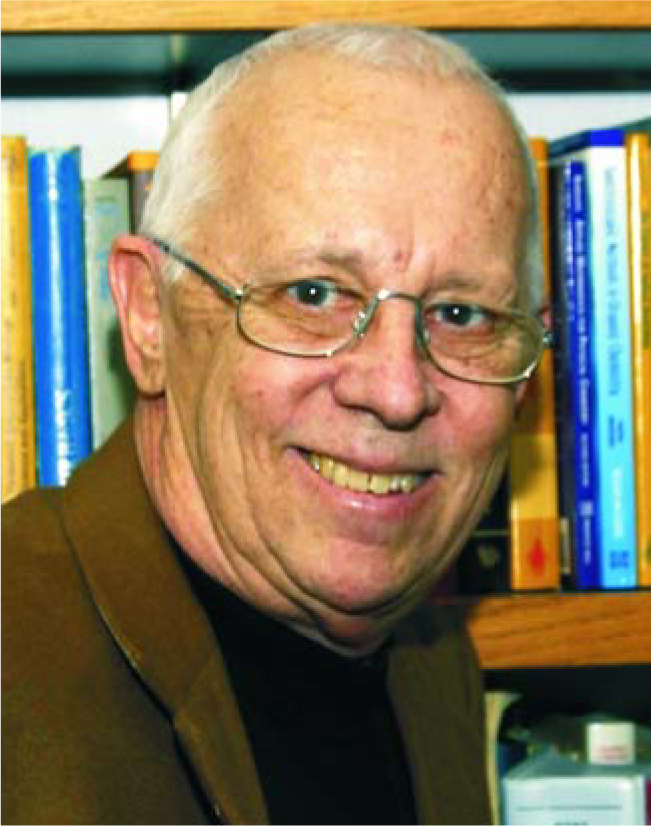Gerald James Small
DOI: 10.1063/1.1897535
Gerald James Small, a leading physical chemist and pioneer in spectroscopy and photosynthesis, died in Ames, Iowa, on 7 August 2004 after a courageous battle with lung cancer.
Gerry was born on 18 January 1941 in Vancouver, British Columbia. He earned a BSc in chemistry and mathematics in 1963 from the University of British Columbia and a PhD in chemistry in 1967 from the University of Pennsylvania, where he was the first student of one of us (Hochstrasser).
Following a postdoctoral fellowship in 1969 with David P. Craig at the Australian National University in Canberra, Gerry joined the chemistry department of Iowa State University in Ames. He became a distinguished professor of liberal arts and sciences and spent his academic career at Iowa State.
By following the quantitative physical chemistry approach and insisting on the highest standards, Gerry orchestrated important discoveries in chemical physics, biophysics, and medical diagnostics, and has had a lasting impact on these fields. Yet, he was a genuinely modest person who did not hyperbolize his contributions. In fact, he was the first to point out the essential roles of his collaborators and other investigators.
In his earliest work, Gerry focused on low-temperature spectra of mixed molecular crystals. He explained the mysterious occurrence of multiplets in the optical spectra of aromatic hydrocarbons in frozen solids and quantitatively explained them by simulating the structure distributions of impurity molecules in crystals. In the 1970s, he explored new spectroscopic approaches to examining phonon relaxation in molecular aggregates. That effort led to his developing the basic model of fluctuating two-level systems to explain spectra of amorphous molecular solids and glasses. He provided fundamental insights into the dynamics of strongly coupled excitons and photons in molecular crystals and imparted essential knowledge of coupling, coherence, and intermolecular forces in aggregates and organic nanostructures.
In 1978, Gerry introduced the method of nonphotochemical hole-burning, in which line-narrowed absorption spectra of inhomogeneously broadened bands are obtained without photochemical destruction of the material. That method led to his discoveries in organic and biological materials. His approach allowed him to unravel the detail behind broadband molecular spectra and yielded new knowledge of dispersive kinetics, dephasing mechanisms, and relaxation processes. His unbounded enthusiasm for his science then led him to use line-narrowing spectroscopic techniques to expand an understanding of photosynthesis.
His first major success in photosynthesis came in 1986, when he and Iowa State colleague John Hayes reported line-narrowed spectra of the primary electron donor of photosynthetic bacteria, a special pair of chlorophylls involved in the initial act of photochemical charge separation. At that time, some thought the separation occurred in 20 femtoseconds. However, Gerry proved that this fast relaxation of the special pair is due to strong electron–phonon coupling and not to the electron transfer that occurs in about 1 picosecond. His findings explained the transients seen in ultrafast laser experiments. Measurements capable of providing information in that very fast time scale were brought into agreement with each other primarily because of Gerry’s efforts.
Gerry used similar methods to determine the Franck-Condon factors associated with the spectral density of the rate coefficient for energy transfer in the light-harvesting molecules that mediate photosynthesis. He also quantified the static energy disorder of proteins and characterized the exciton bands of the light harvesters of purple bacteria. He noticed that his results could be explained by assuming cyclic symmetry for those complexes. The high-resolution x-ray structures and quantum chemical calculations that followed supported his benchmark interpretation.
Gerry also measured the correlations of how the complexes’ excited state energies were distributed, and, in work in 1992 with Bob Silbey of MIT, he defined the conditions for the complexes’ dispersive kinetics. By combining hole-burning and Stark effects, he identified the presence of exchange coupling in photosystem I of green plants, cyanobacteria, and photosystem II, a protein-pigment complex involved in oxygen production in algae and higher plants. The techniques and views he championed are now essential to those investigating the photosynthetic process.
In 1984, in work that advanced analytical methods for diagnosis, Gerry and Alan Jeffrey of the Cancer Institute (now the Institute for Cancer Genetics) at Columbia University used fluorescence line narrowing to characterize the structures of DNA carcinogen adducts. As Gerry showed in his 2002 work with Lynn Hartmann of the Mayo Clinic, that method distinguishes normal and carcinoma ovarian surface epithelial cells. In 2004, Gerry and Ryszard Jankowiak of Iowa State developed a line-narrowing method involving monoclonal antibody (gold biosensor chip that detects DNA carcinogen interactions at the level of one adduct in 108 base pairs). For his numerous analytical discoveries, Gerry won a Research and Development 100 Award from the US Department of Energy in 1998.
Gerry was exceptionally kind and considerate, liked by everyone who knew him. His great number of close friends and colleagues from across the world miss him and think of him often.

Gerald James Small

More about the Authors
Robin M. Hochstrasser. 1 University of Pennsylvania, Philadelphia, US .
James R. Norris. 2 University of Chicago, Chicago, Illinois, US .
Shaul Mukamel. 3 University of California, Irvine, US .
